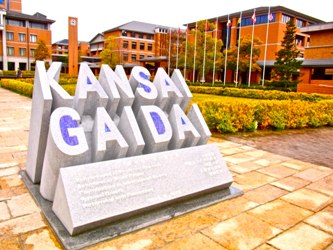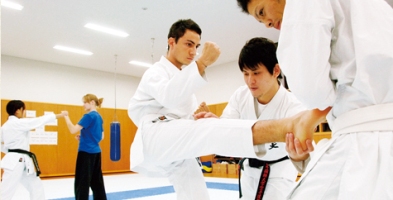Kansai Gaidai University
Asian Studies Program
Osaka, Japan
Kansai Gaidai is located in Hirakata City, Osaka and is accessible, within a one-hour train ride, to Kyoto and Nara, the ancient capitals, and Osaka, which is the second largest business hub in Japan. Nestled in the cultural heart of Japan, the campus provides an excellent starting point from which to begin exploring this truly fascinating land. Many of the cities in the Kansai region are extensively utilized in the Asian Studies Program through field trips, independent research, and/or case studies.
Must have a 3.0 GPA to apply.
The Asian Studies Program provides international students with a means of exploring Japan and Asian studies through classroom instruction and interaction with Japanese people. Japanese language courses range from the introductory through the advanced levels. Previous Japanese language training is not required as all courses, except for Japanese language courses, are conducted in English. Kansai Gaidai has a student population of 10,000, 600 of which are international students accepted into the Asian Studies Program.
The Curriculum of the Asian Studies Program is twofold; the rigorous Japanese language studies and courses in the Social Sciences, Humanities, and Business/Economics pertinent to Japan and Asia make it possible for participants to approach a wide array of study areas during their stay in Japan. Japanese language instruction also plays a key role. Below is a list of the types of courses that are typically offered:

- Asian Economic Integration and Globalization (fall & spring)
- Contemporary Japanese Economy and Business (fall & spring)
- Political Economies of East Asia (fall & spring)
- Principles of Economics with Applications to the Japanese Economy (fall & spring)
- Labor, Culture & HRM Operations (fall & spring)
- Intercultural Business Communication in Japan (fall & spring)
- International Business: Doing Business in East Asia (fall & spring)
- International Business: The Japanese Transnational Corporation (TNC) (fall & spring)
- Japanese Business: Business and Management in the Asia-Pacific (fall & spring)
- Advertising and Integrated Marketing Communications (fall & spring)
- International Entrepreneurship: Focus on Japan (fall & spring)
- International Negotiation: Resolving Conflict and Closing the Deal (fall & spring)
- The Struggle for Justice (fall & spring)
- The Dynamics of Modern Japan (fall)
- Japan and China: Problems in Historical & Cultural Interactions (fall & spring)
- Pacific Rivalry (fall & spring)
- Peace, Development, and Democratization: The Asia Challenge (fall & spring)
- Challenges in Modern Japanese History and Politics (spring)
- Introduction to Japanese History (fall & spring)
- Survey of Japanese Art (fall)
- Japan and Its World to 1860 (spring)
 Culture and Everyday Life in Japan: Japanese Society in Anthropological Perspective (fall & spring)
Culture and Everyday Life in Japan: Japanese Society in Anthropological Perspective (fall & spring)- Popular Culture as Social Practice: Producing Pleasures, Styles, Identities (fall & spring)
- Onna to Otoko: Gender and Sexuality in Japan (fall & spring)
- Sexuality and Culture in Japan: Desire, Power and Social Order (fall & spring)
- The Body and Communication in Japan (fall & spring)
- Issues in Contemporary Japanese Society and Culture (fall & spring)
- Japan and Globalization: A Cultural Approach (fall & spring)
- Visual Anthropology of Japan (fall & spring)
- Intercultural Communication in Japan (fall & spring)
- Japanese Communication: Culture as Performance (fall & spring)
- Japanese Popular Media and Culture (fall & spring)
- Japan in Western Film and Literature (fall & spring)
 Japanese Buddhism (fall & spring)
Japanese Buddhism (fall & spring)- Religion in Japan (fall)
- Shinto (fall & spring)
- Zen Buddhism (fall & spring)
- Death in East Asian Thought (spring)
- Asian Psychologies (fall & spring)
- Cross-Cultural Psychology (fall & spring)
- Cross-Cultural Social Experience (fall & spring)
- Anime: Method and Meaning (fall & spring)
- New Japanese Cinema 1995-2005 (fall & spring)
- From Zen to Paradise (fall & spring)
- Japanese Buddhist Art (fall & spring)
